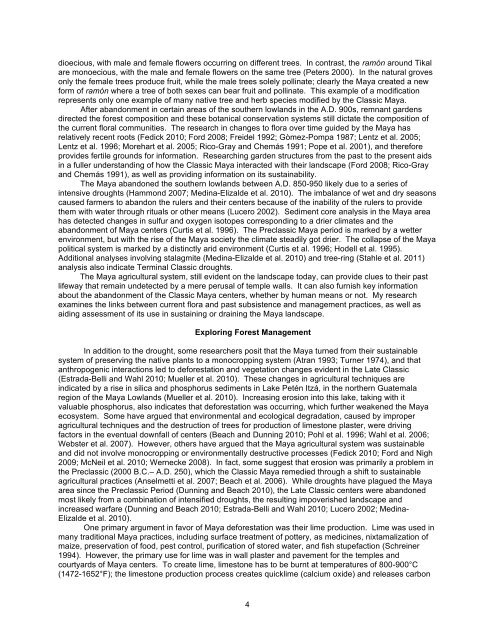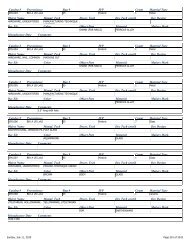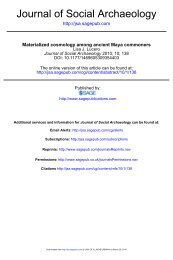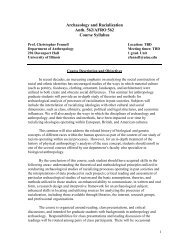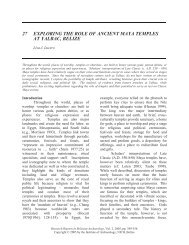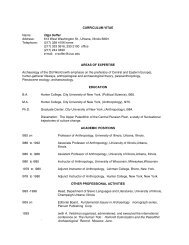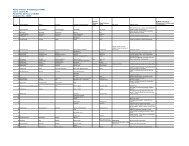dioecious, with male and female flowers occurring on different trees. In contrast, the ramón around Tikalare monoecious, with the male and female flowers on the same tree (Peters 2000). In the natural grovesonly the female trees produce fruit, while the male trees solely pollinate; clearly the Maya created a newform of ramón where a tree of both sexes can bear fruit and pollinate. This example of a modificationrepresents only one example of many native tree and herb species modified by the Classic Maya.After abandonment in certain areas of the southern lowlands in the A.D. 900s, remnant gardensdirected the forest composition and these botanical conservation systems still dictate the composition ofthe current floral communities. The research in changes <strong>to</strong> flora over time guided by the Maya hasrelatively recent roots (Fedick 2010; Ford 2008; Freidel 1992; Gòmez-Pompa 1987; Lentz et al. 2005;Lentz et al. 1996; Morehart et al. 2005; Rico-Gray and Chemás 1991; Pope et al. 2001), and thereforeprovides fertile grounds for information. Researching garden structures <strong>from</strong> the past <strong>to</strong> the present aidsin a fuller understanding of how the Classic Maya interacted with their landscape (Ford 2008; Rico-Grayand Chemás 1991), as well as providing information on its sustainability.The Maya abandoned the southern lowlands between A.D. 850-950 likely due <strong>to</strong> a series ofintensive droughts (Hammond 2007; Medina-Elizalde et al. 2010). The imbalance of wet and dry seasonscaused farmers <strong>to</strong> abandon the rulers and their centers because of the inability of the rulers <strong>to</strong> providethem with water through rituals or other means (Lucero 2002). Sediment core analysis in the Maya areahas detected changes in sulfur and oxygen iso<strong>to</strong>pes corresponding <strong>to</strong> a drier climates and theabandonment of Maya centers (Curtis et al. 1996). The Preclassic Maya period is marked by a wetterenvironment, but with the rise of the Maya society the climate steadily got drier. The collapse of the Mayapolitical system is marked by a distinctly arid environment (Curtis et al. 1996; Hodell et al. 1995).Additional analyses involving stalagmite (Medina-Elizalde et al. 2010) and tree-ring (Stahle et al. <strong>2011</strong>)analysis also indicate Terminal Classic droughts.The Maya agricultural system, still evident on the landscape <strong>to</strong>day, can provide clues <strong>to</strong> their pastlifeway that remain undetected by a mere perusal of temple walls. It can also furnish key informationabout the abandonment of the Classic Maya centers, whether by human means or not. My researchexamines the links between current flora and past subsistence and management practices, as well asaiding assessment of its use in sustaining or draining the Maya landscape.Exploring Forest ManagementIn addition <strong>to</strong> the drought, some researchers posit that the Maya turned <strong>from</strong> their sustainablesystem of preserving the native plants <strong>to</strong> a monocropping system (Atran 1993; Turner 1974), and thatanthropogenic interactions led <strong>to</strong> deforestation and vegetation changes evident in the Late Classic(Estrada-Belli and Wahl 2010; Mueller et al. 2010). These changes in agricultural techniques areindicated by a rise in silica and phosphorus sediments in Lake Petén Itzá, in the northern Guatemalaregion of the Maya Lowlands (Mueller et al. 2010). Increasing erosion in<strong>to</strong> this lake, taking with itvaluable phosphorus, also indicates that deforestation was occurring, which further weakened the Mayaecosystem. Some have argued that environmental and ecological degradation, caused by improperagricultural techniques and the destruction of trees for production of limes<strong>to</strong>ne plaster, were drivingfac<strong>to</strong>rs in the eventual downfall of centers (Beach and Dunning 2010; Pohl et al. 1996; Wahl et al. 2006;Webster et al. 2007). However, others have argued that the Maya agricultural system was sustainableand did not involve monocropping or environmentally destructive processes (Fedick 2010; Ford and Nigh2009; McNeil et al. 2010; Wernecke 2008). In fact, some suggest that erosion was primarily a problem inthe Preclassic (2000 B.C.– A.D. 250), which the Classic Maya remedied through a shift <strong>to</strong> sustainableagricultural practices (Anselmetti et al. 2007; Beach et al. 2006). While droughts have plagued the Mayaarea since the Preclassic Period (Dunning and Beach 2010), the Late Classic centers were abandonedmost likely <strong>from</strong> a combination of intensified droughts, the resulting impoverished landscape andincreased warfare (Dunning and Beach 2010; Estrada-Belli and Wahl 2010; Lucero 2002; Medina-Elizalde et al. 2010).One primary argument in favor of Maya deforestation was their lime production. Lime was used inmany traditional Maya practices, including surface treatment of pottery, as medicines, nixtamalization ofmaize, preservation of food, pest control, purification of s<strong>to</strong>red water, and fish stupefaction (Schreiner1994). However, the primary use for lime was in wall plaster and pavement for the temples andcourtyards of Maya centers. To create lime, limes<strong>to</strong>ne has <strong>to</strong> be burnt at temperatures of 800-900°C(1472-1652°F); the limes<strong>to</strong>ne production process creates quicklime (calcium oxide) and releases carbon4
dioxide (Schreiner 1994). The fuel requirement <strong>to</strong> create enough lime <strong>to</strong> coat one temple at El Mirador(El Tigre pyramid, the second largest at the site) was the equivalent of the annual returns of 16.3 km(1,630 ha) of forest. Extending the estimate <strong>to</strong> the other cities and connecting causeways in the entireMirador Basin, a forest of 19,590 km (1,956,000 ha) needs <strong>to</strong> be harvested annually (Schreiner 1994).However, the “destructive” lime technology has proved <strong>to</strong> be more sophisticated and less environmentallydamaging than previously believed (Wernecke 2008). One confounding observation is that lime is onlyone ingredient <strong>to</strong> the plaster; binders and aggregates would have decreased the need for pure lime(Wernecke 2008). Also, through the effects of time on degrading lime, it is impossible <strong>to</strong> differentiatebetween burnt-lime and calcium carbonate substitutes (i.e. sascab). Sascab is a soft limes<strong>to</strong>neconglomerate, or calcareous sand, that was used in Maya monumental architecture construction as asubstitute for burned lime (Littmann 1958). Sascab is easily compacted and was used for fill, plaster,mortar and lime-sascab mixtures (Erasmus 1965; Folan 1978; Littmann 1958, 1962). This reddish-yellow<strong>to</strong> white unconsolidated limes<strong>to</strong>ne forms a clay-like paste when wet, and hardens in<strong>to</strong> a cement-likematerial when dry (Rapp 2009; Wernecke 2008). These two considerations have made the question ofdeforestation in<strong>to</strong> a hotly contested debate. This debate is one aspect of the competing hypothesesregarding Maya environmental effects: (1) they degraded their landscape, (2) they sustained it.The first hypothesis assumes that the Maya changed their environment resulting in erosion. Thesecond assumes that the Maya conserved the forest by keeping key components of the landscape, suchas native trees and herbs, intact while incorporating domesticates, thus favoring a modern landscape notmuch changed <strong>from</strong> the ancient one. The first hypothesis would lead us <strong>to</strong> assume that Maya landscapemodifications not only were detrimental <strong>to</strong> the environment, but that they ultimately led <strong>to</strong> the collapse ofthe Maya society. Thus, their efforts at environmental changes need only <strong>to</strong> be examined as relics ofcultures past with no positive contributions for present conserva<strong>to</strong>ry goals.In contrast, the second hypothesis assumes that forest management allowed the forest <strong>to</strong>regenerate in ways that were beneficial <strong>to</strong> the environment and conserved the ancient floral populationslong after the area was abandoned. If this was the case, Maya conservation attempts, which preservedancient flora and allowed a natural turning of the landscape <strong>from</strong> field back <strong>to</strong> forest, can aid scientistsseeking <strong>to</strong> halt the erosion of the tropical rainforests, aid botanists attempting <strong>to</strong> understand the his<strong>to</strong>ry offorests, and aid archaeologists searching for cultural attributes of the forests surrounding ancienthabitation sites.To assess if this were the case, the Maya landscape management process needs <strong>to</strong> be examinedas a blueprint for modern tropical conservation efforts. My research seeks <strong>to</strong> uncover what the impactsand results of the Classic Maya landscape changes are by examining the merits and downfalls of bothhypotheses. There is growing support for the second hypothesis, indicating a sustainable agriculturalpractice that withs<strong>to</strong>od societal and environmental stress. This model poses implications for modernsustainability research, providing a usable method for conserving the tropical forest while propagatinguseful plants. The Classic Maya agricultural system, no matter how ingeniously devised, still requiredgood <strong>to</strong>psoil <strong>to</strong> produce crops, which further bears on forest management strategy.Soil ClassesScott Fedick developed a soil classification system whereby he classified soil based on capabilityof supporting crops and suitability for them. Fedick assesses three different fac<strong>to</strong>rs: soil, parentmaterials, and <strong>to</strong>pography finding correlations between soil types and Maya settlement density (Fedick1995, 1996). To further distinguish soil types, Fedick divided them in<strong>to</strong> capability classes based oneffective root zone, susceptibility <strong>to</strong> erosion, workability, drainage, and inherent fertility. These fac<strong>to</strong>rswere combined <strong>to</strong> create five capability classes: Classes I (alluvium) and II were more suitable forfarming; while Class III had fairly poor soils and was used infrequently. Classes IV and V soil were strictlynon-farmable lands.The Maya were familiar with the soils and used their own classification system (Barrera-Bassols etal. 2006). Current Maya soil classification, as demonstrated through ethnographic analysis, involvestexture, color, consistence and s<strong>to</strong>niness (Barrera-Bassols and Toledo 2005; Rainey 2005; Wells andMihok 2010). Soil was also classified according <strong>to</strong> the context of potential use, including agriculturalpotential, hazards, etc.Fedick found that some people lived in lower classes of land than would have been expected(Fedick et al. 2008). Farmers might have used these less-fertile lands on which <strong>to</strong> build houses whilethey farmed better land nearby. Fedick also notes that Class II soils supported a higher population than5
- Page 1 and 2: UNIVERSITY OF ILLINOISURBANA-CHAMPA
- Page 3 and 4: AcknowledgmentsSpecial thanks to Cl
- Page 5 and 6: !"#$%&'(&)'*+%*+,!!"#$%&'%(")*+,#%-
- Page 8 and 9: I first present a brief background
- Page 13: Figure 5: Yalbac, Courtesy of VOPAD
- Page 16 and 17: as well as the flora located on top
- Page 18 and 19: (diameter) circle. Traverse point Y
- Page 20 and 21: collecting from Plot 3, my collecti
- Page 22 and 23: Figure 12: Plot 6, between Mounds 9
- Page 24 and 25: M10610, and surveyed plants between
- Page 26 and 27: ResultsThe preliminary results of m
- Page 28 and 29: “Bird Pepper”Solanum spp. Solan
- Page 30: their rulers to trees (Freidel 1992
- Page 33 and 34: Gómez-Pompa, A.1987 On Maya Silvic
- Page 35 and 36: Mesoamerica. Science 292: 1370-1373
- Page 37 and 38: Col. #FamilyName Genus SpeciesEngli
- Page 39 and 40: 34 Pulil Used for firewoord, prickl
- Page 41 and 42: 70Euphorbiaceae/UlmaceaeDrypetes/Am
- Page 43 and 44: 108 Amaree San Jwan Tree grows larg
- Page 45 and 46: 142 Little treeLittle tree, narrow
- Page 47 and 48: 174 Little treeLittleepiphytic175vi
- Page 49 and 50: 205SelaginellaceaeSelaginellaerythr
- Page 51 and 52: 231Annonaceae Annona glabraMammon(m
- Page 53 and 54: 271272Solanaeae Solanum spp. Bird p
- Page 56 and 57: 766211ApocynaceaeApocynaceaeAnacard
- Page 58 and 59: 70Euphorbiaceae/Ulmaceae262 Apiacea
- Page 60 and 61:
169 Piperaceae Piper spp.Nyctaginac
- Page 62 and 63:
eae117Myristicaceae Virola koschnyi
- Page 64 and 65:
56Tree easyto breakTree is easy to
- Page 66 and 67:
133 Small treeSmall tree with senna
- Page 68 and 69:
165 Hardwood166 MonachHardwood, gra
- Page 70 and 71:
204Vine with aprickle(solanum)Prick
- Page 72 and 73:
APPENDIX IIIPlant List by Use66
- Page 74 and 75:
262 Apiaceae1ApocynaceaeEryngium/Co
- Page 76 and 77:
31 Spice Tree nab'a'-ku'ukFruit lik
- Page 78 and 79:
33 Asteraceae Koanophyllon galeotti
- Page 80 and 81:
179 Hardwood197 Hoyub-cheh juyub'-c
- Page 82 and 83:
122Nyctaginaceae58 OlacaceaeSchoepf
- Page 84 and 85:
106Vine with bigpricklesVine with b
- Page 86 and 87:
155 Small plant3 leaf clusters, sli
- Page 88:
213Vine with aprickleVine with a pr


